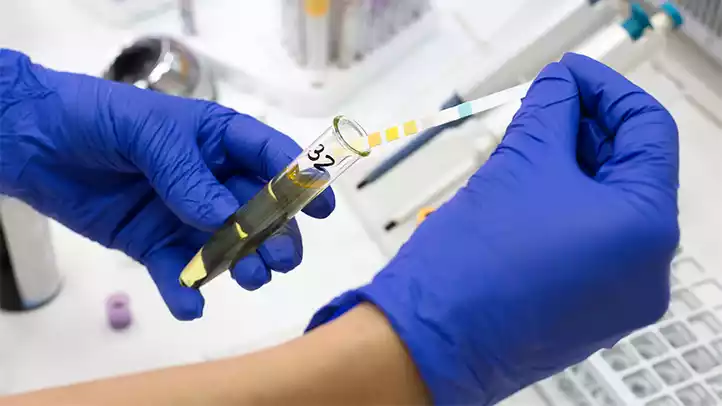Introduction
Urine analysis plays a crucial role in diagnosing and monitoring various medical conditions. Two common methods used for urine testing are the Urine Dipstick and Urinalysis. Both methods provide valuable information about a person’s health, but they differ in their scope, methodology, and clinical applications. Understanding the differences between these two tests is essential for healthcare professionals and patients alike. This comprehensive article will delve into the intricacies of Urine Dipstick and Urinalysis, providing a thorough examination of their principles, applications, advantages, disadvantages, clinical significance, limitations, and considerations for interpretation.
What is Urine Dipstick?
Urine Dipstick, also known as a urinalysis dipstick or dip-and-read test, is a rapid and convenient diagnostic tool that provides a quick assessment of the chemical composition of urine. It consists of a thin, plastic strip embedded with various chemical reagents, which react with specific substances in the urine, producing a color change that can be visually interpreted. This method is commonly used for initial, on-the-spot testing in various healthcare settings.

Types of Urine Dipstick
Urine Dipsticks are available in a variety of types, with each type targeting specific analytes. Common types include:
- Basic Urinalysis Dipstick: This type assesses the presence of parameters like pH, specific gravity, protein, glucose, ketones, bilirubin, urobilinogen, and nitrites in urine.
- Microalbuminuria Dipstick: Specifically designed to detect minute amounts of albumin in the urine, making it useful for detecting early kidney disease.
- Multistix Dipstick: This type covers a wide range of parameters, including those assessed by basic urinalysis dipsticks along with creatinine and blood, making it suitable for a more comprehensive evaluation.
- Urine Pregnancy Test Dipstick: Primarily used for determining pregnancy through the detection of human chorionic gonadotropin (hCG) hormone in urine.
- Drug Screening Dipstick: Utilized for screening common drugs of abuse by detecting their metabolites in urine.
Primary Uses of Urine Dipstick
Urine Dipstick has a range of applications, including:
- Screening for Kidney Disease: By assessing protein levels and other markers, it can indicate the presence of kidney disease or dysfunction.
- Detecting Diabetes: High levels of glucose in the urine may suggest uncontrolled diabetes.
- Monitoring Pregnancy: Urine pregnancy tests are widely used to confirm pregnancy.
- Evaluating Urinary Tract Infections (UTIs): The presence of nitrites and leukocyte esterase can indicate a UTI.
- Assessing Liver Function: The presence of bilirubin and urobilinogen in urine may indicate liver problems.
- Monitoring Drug Use: Drug screening dipsticks can detect the presence of illicit drugs or their metabolites.
Advantages and Disadvantages of Urine Dipstick
Advantages of Urine Dipstick
- Rapid Results: Urine Dipstick provides quick results, making it suitable for initial screening.
- Non-Invasive: It is a non-invasive and painless procedure, making it well-tolerated by patients.
- Cost-Effective: It is relatively inexpensive, making it accessible for routine testing.
- Portability: Dipsticks are portable and can be used in various healthcare settings, including clinics and homes.
Disadvantages of Urine Dipstick
- Limited Specificity: Dipstick results may produce false positives or negatives and often require confirmation through more specific tests.
- Semi-Quantitative: The results are semi-quantitative, making it challenging to precisely measure analyte concentrations.
- Subjectivity: Interpretation of color changes can be subjective and may vary among individuals.
- Interference: Some substances and medications may interfere with dipstick results.
What is Urinalysis?
Urinalysis, also known as a urine test or urinary analysis, is a comprehensive laboratory method that involves the physical, chemical, and microscopic examination of urine. Unlike Urine Dipstick, urinalysis provides a detailed and precise analysis of urine composition, including the identification of cellular elements and microorganisms under a microscope.

Primary Uses of Urinalysis
Urinalysis serves multiple diagnostic and monitoring purposes, including:
- Evaluating Kidney Function: It assesses glomerular filtration rate, kidney health, and detects renal diseases.
- Detecting UTIs: Urinalysis identifies the presence of bacteria, white blood cells, and other signs of urinary tract infections.
- Screening for Diabetes: It measures glucose levels in urine, which is particularly useful in diagnosing diabetes.
- Monitoring Metabolic Disorders: By assessing various substances in urine, urinalysis can detect metabolic disorders such as phenylketonuria (PKU) and porphyria.
- Identifying Renal Stones: Microscopic examination can reveal crystals or calculi, aiding in the diagnosis of kidney stones.
- Drug Testing: Urinalysis is used in drug testing programs, such as workplace and athletic drug screenings.
Process of Urinalysis
Urinalysis involves a multi-step process that includes the following components:
- Physical Examination: This step includes evaluating the color, clarity, odor, and volume of urine. Unusual colors or turbidity can indicate underlying medical conditions.
- Chemical Examination: A urinalysis strip is used to assess various chemical parameters, such as pH, specific gravity, glucose, protein, blood, ketones, bilirubin, urobilinogen, and nitrites.
- Microscopic Examination: Under a microscope, urine is examined for the presence of cells (red and white blood cells), casts, crystals, bacteria, and other microorganisms.
Advantages and Disadvantages of Urinalysis
Advantages of Urinalysis
- Comprehensive Analysis: Urinalysis offers a more comprehensive assessment of urine composition, including microscopic evaluation.
- Highly Specific: It provides more specific and precise results compared to Urine Dipstick.
- Quantitative Data: Urinalysis provides quantitative data on the concentration of various substances in urine.
- Detection of Cellular Elements: It can identify abnormal cellular elements, aiding in the diagnosis of specific conditions.
Disadvantages of Urinalysis
- Time-Consuming: Urinalysis is a relatively time-consuming process compared to the rapid results of Urine Dipstick.
- Requires Laboratory Equipment: It necessitates access to a laboratory with microscopy and the necessary equipment.
- More Expensive: Urinalysis is typically more expensive than a basic Urine Dipstick test.
- Invasive for Some Patients: Collecting a urine sample for urinalysis can be less comfortable for patients compared to a dipstick test.
Importance of Knowing the Difference Between Urine Dipstick and Urinalysis
Understanding the distinction between Urine Dipstick and Urinalysis is vital for both healthcare professionals and patients for several reasons:
- Clinical Decision-Making: Proper diagnosis and treatment decisions depend on the accuracy and specificity of the test used. Knowing which test is appropriate in a given clinical scenario is crucial for optimal patient care.
- Cost-Efficiency: Recognizing when a quick Urine Dipstick test is sufficient can help reduce healthcare costs, as urinalysis can be more expensive and time-consuming.
- Clinical Significance: The results of each test hold different clinical significance. Urinalysis provides a more in-depth assessment of kidney health and other conditions, whereas a Urine Dipstick may be suitable for initial screening.
- Patient Education: Patients should be informed about the tests they are undergoing, including the differences between them. This can lead to better patient compliance and understanding.
- Disease Management: Differentiating between the two tests is crucial for effective management of chronic conditions, such as diabetes or kidney disease.
Difference Table of Urine Dipstick and Urinalysis
Let’s create a table to highlight the key differences between Urine Dipstick and Urinalysis:
| Aspect | Urine Dipstick | Urinalysis |
| Methodology | Chemical reagents on a strip | Physical, chemical, and microscopic examination in a laboratory setting |
| Scope | Limited to specific analytes | Comprehensive, including all aspects of urine composition |
| Speed of Results | Rapid, within minutes | Typically slower, requiring laboratory analysis |
| Specificity | Limited, may produce false positives or negatives | Highly specific, providing more precise results |
| Quantitative Data | Semi-quantitative | Quantitative, offering precise concentration values |
| Detection of Cellular Elements | No, does not detect cells | Yes, can identify cells like red and white blood cells |
| Use in Drug Testing | Yes, for preliminary screening | Yes, commonly used for drug testing |
| Cost | Inexpensive | More expensive, especially when additional tests are required |
| Clinical Setting | Suitable for quick on-site screening | Typically used in a laboratory setting |
What Are the Similarities Between Urine Dipstick and Urinalysis?
While Urine Dipstick and Urinalysis differ significantly in their scope and methodology, they share some commonalities:
- Urine Sample Requirement: Both tests require a urine sample as the primary specimen for analysis.
- Diagnostic Tools: They are both diagnostic tools used to assess a person’s health, especially related to kidney function and urinary tract conditions.
- Use in Drug Testing: Both Urine Dipstick and Urinalysis are used for drug testing, although Urinalysis is more commonly employed for confirmatory drug tests.
- Parameter Overlap: Some parameters assessed by Urine Dipstick, such as glucose, protein, and blood, are also evaluated in Urinalysis.
- Clinical Relevance: Both tests are relevant in clinical practice, but their applications differ based on the clinical scenario and required depth of analysis.
Clinical Applications and Significance

Clinical Applications of Urine Dipstick
Urine Dipstick is primarily used in various clinical scenarios, including:
- Point of Care Testing: It is ideal for rapid screening in primary care settings, emergency rooms, and clinics.
- Detecting UTIs: Dipsticks are valuable in identifying the presence of nitrites and leukocyte esterase, indicative of urinary tract infections.
- Screening for Diabetes: Elevated glucose levels can suggest diabetes, prompting further evaluation.
- Monitoring Pregnancy: Urine pregnancy tests are widely used to confirm pregnancy during early gestation.
- Drug Screening: Dipsticks are the initial screening method for detecting drug use, followed by confirmatory tests when necessary.
Clinical Significance of Urinalysis
Urinalysis provides a more comprehensive assessment and is crucial in various clinical scenarios:
- Evaluation of Kidney Function: Urinalysis is essential for assessing glomerular filtration rate and detecting kidney diseases like glomerulonephritis or nephrotic syndrome.
- Identifying UTIs and Other Infections: It helps in diagnosing bacterial, viral, or fungal infections of the urinary tract.
- Screening for Diabetes: Urinalysis is used to confirm diabetes diagnosis, especially when blood glucose levels are borderline.
- Monitoring Metabolic Disorders: For disorders like phenylketonuria or porphyria, urinalysis provides essential diagnostic information.
- Detection of Kidney Stones: Microscopic examination can reveal the presence of crystals or calculi, aiding in the diagnosis of kidney stones.
- Drug Testing Programs: Urinalysis is the preferred method for workplace and athletic drug screenings, providing quantitative data about drug metabolites.
Limitations of Urine Dipstick and Urinalysis
Understanding the limitations of each test is essential for accurate interpretation and diagnosis:
Limitations of Urine Dipstick
- Lack of Specificity: Dipstick tests can produce false positives or negatives due to the presence of interfering substances or variations in pH.
- Semi-Quantitative Data: Dipsticks provide only semi-quantitative data, making it challenging to assess the severity of conditions accurately.
- Subjectivity: Interpreting color changes can be subjective and may vary between individuals.
- Inability to Detect Cells: Urine Dipstick cannot detect cellular elements like red and white blood cells, which are critical for diagnosing specific conditions.
- Limited Scope: Dipstick tests cover a limited range of parameters compared to the comprehensive analysis of urinalysis.
Limitations of Urinalysis
- Time-Consuming: Urinalysis is relatively time-consuming, requiring laboratory analysis, which can delay diagnosis and treatment.
- Costly: It is more expensive than Urine Dipstick testing, particularly when additional laboratory tests are necessary.
- Invasive Sample Collection: Collecting a urine sample for urinalysis may be less comfortable for patients compared to a quick dipstick test.
- Laboratory Requirement: Urinalysis requires access to a laboratory with specialized equipment, limiting its use in remote or point-of-care settings.
Challenges and Considerations in Interpretation
Both Urine Dipstick and Urinalysis results require careful interpretation to arrive at accurate conclusions:
Challenges in Interpretation
- False Positives and Negatives: Urine Dipstick and Urinalysis results may be influenced by factors like medications, diet, and hydration status, leading to false positives or negatives.
- Interference: Various substances in the urine can interfere with test results, potentially leading to misinterpretation.
- Variability in Color Perception: Interpreting color changes in Urine Dipstick tests is subjective and can vary between individuals.
- Microscopic Examination: Microscopic findings in Urinalysis require a trained eye, and the presence of cells, crystals, or microorganisms may be missed by inexperienced laboratory staff.
Considerations in Interpretation
- Clinical Context: The clinical context and the patient’s medical history are critical in interpreting results and making a diagnosis.
- Confirmation Tests: In cases of uncertainty or when results are borderline, confirmatory tests may be necessary to reach a definitive diagnosis.
- Serial Testing: In certain conditions, serial testing may be required to monitor changes in urine composition over time and assess treatment effectiveness.
- Patient Communication: Effective communication with the patient is crucial to ensure they understand the results and the implications for their health.
When to Use Each Test
The choice between Urine Dipstick and Urinalysis depends on the clinical scenario, the required depth of analysis, and the availability of resources:
- Use Urine Dipstick When:
-
- Rapid screening is necessary, such as in emergency care.
- A quick assessment of basic parameters like glucose, protein, and ketones is sufficient.
- A preliminary assessment for conditions like UTIs or diabetes is needed.
- Point-of-care testing is preferred due to limited resources.
- Use Urinalysis When:
-
- A comprehensive assessment of urine composition is required, especially for kidney function evaluation.
- The presence of cellular elements, such as red or white blood cells, is suspected.
- Confirmatory testing is needed to rule out false positives or negatives from dipstick tests.
- A more accurate assessment of metabolic or renal disorders is crucial.
- Monitoring chronic conditions like kidney disease or diabetes over time.
Conclusion
Urine Dipstick and Urinalysis are indispensable tools in healthcare, each with its own set of advantages and limitations. Urine Dipstick offers quick, cost-effective initial screening, while Urinalysis provides a more comprehensive and precise analysis of urine. Choosing the right test is essential for accurate diagnosis and treatment. Healthcare professionals must be mindful of the differences between these methods, as well as their clinical significance, to ensure patients receive the most appropriate care and facilitate informed decision-making in the medical field.



